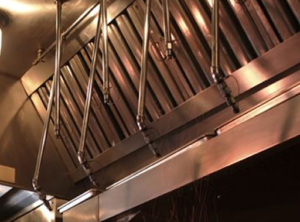Automatic suppression systems are vital for protection against fire in commercial cooking.
The system has fusible links installed in the hood plenum area and, when a fire occurs, the
link separates and activates the suppression system. A suppression agent is released from
a series of nozzles, smothering the fire and creating a foam blanket to prevent re-ignition. In
addition, activation of the system shuts off the fuel supply. The suppression system needs
to be UL-300 Compliant, meaning it is specifically designed for modern commercial cooking
appliances that use vegetable oil instead of animal fat. Modern commercial high efficiency
appliances retain heat for longer periods of time and are therefore more difficult to suppress
during a fire. Modern suppression systems are complex and require semi-annual servicing to
ensure proper functioning in the event of fire.
Older suppression systems use dry powder as a suppression agent, which will not create
a foam barrier with vegetable oil appliances and could lead to re-ignition. For this reason,
older dry powder systems need to be replaced with a UL-300 compliant wet type system.

There are an estimated 5,600 restaurant fires reported annually, resulting in over $116M in property damage. *
Most Common Causes of Fires in Restaurants**
- Cooking Equipment is responsible for 57% of restaurant fires.
- Heating Equipment is responsible for 10% of restaurant fires.
- Electrical distribution and lighting equipment is responsible for 7% of restaurant fires
- Smoking is responsible for 7%
- Arson is responsible for 5%
- Failure to keep a clean kitchen was a factor in approximately 22% of fires
*National Fire Incident Reporting System (NFIRS)
** National Fire Protection Association (NFPA)
Includes content provided by Mutual Boiler Re
Hospitality Insurance Group
106 Southville Road, Southborough, MA 01772
www.hmic.com
877-366-1140
